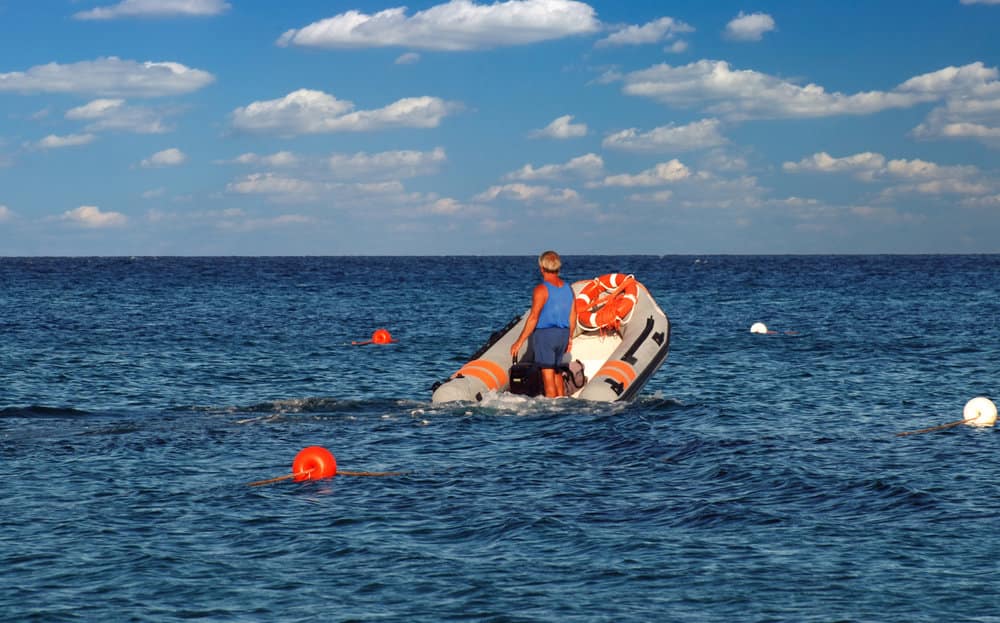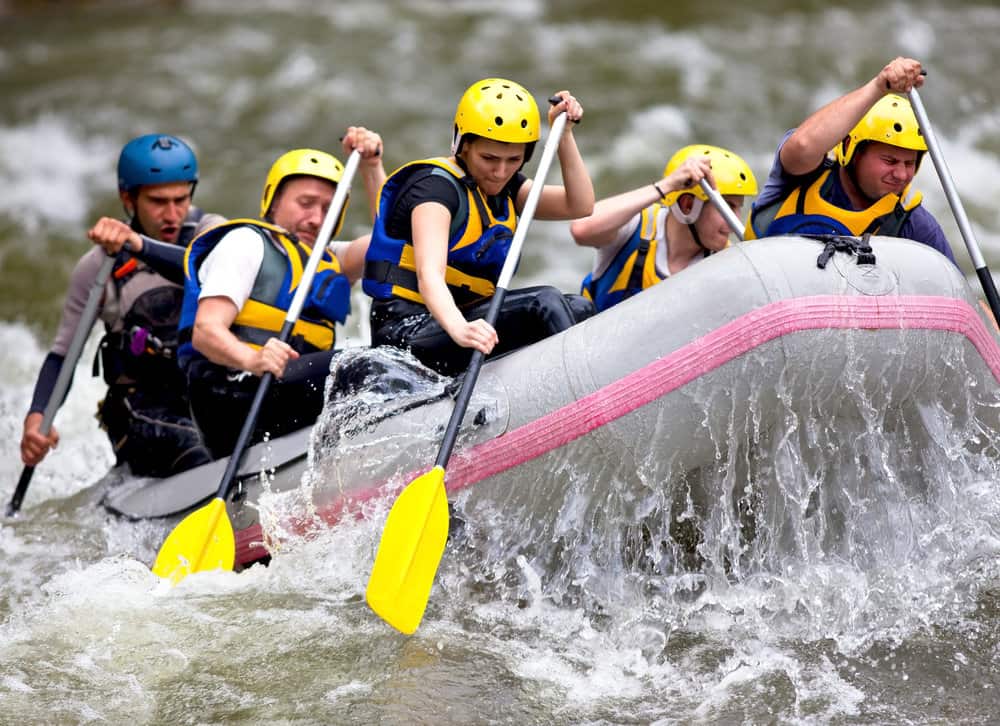Are you worried your inflatable boat can’t carry a trolling motor AND a battery?
Do you want the strongest motor without sinking your boat?
Or perhaps you’re wondering what happens if you go over your boat’s weight limits?
Well, you’ve come to the right place.
Today, we’re taking a look at:
- How heavy trolling motors are
- How heavy marine batteries are
- How heavy inflatable boats can carry
- ALL the frequently asked questions about inflatable boat maximum weights
With these, you’ll never have to worry about overloading your boat.
This is the complete Q&A for inflatable boat weight, so let’s get started!
Table of Contents
- How Heavy Are Trolling Motors?
- How Heavy Are Trolling Motor Batteries?
- How Heavy Are Trolling Motors Plus Their Batteries?
- What Size Battery Do You Need For Trolling Motors?
- What Happens if You Overload Your Inflatable Boat?
- How Heavy Can Inflatable Boats Carry?
- How Heavy Can Inflatable Kayaks Carry?
- Conclusion
How Heavy Are Trolling Motors?
- Low-thrust motors (30-50 lbs thrust) weigh an average of 20-30 lbs.
- Mid-thrust motors (55-75 lbs thrust) weigh around 30-60 lbs.
- High-thrust motors (80+ lbs thrust) usually weigh over 60 lbs.
The weight of trolling motors mostly depends on its pounds of thrust (or power).
There are other factors to consider of course. These include material, shaft length, design, and extra features.
But as a rule of thumb, the higher the thrust, the heavier the motor.
1. Minn Kota Motors
On average, Minn Kota motors weigh 42 lbs.
However, that’s a rough average.
Minn Kota makes motors in all sizes.
From the small 15-lbs Endura to the big and powerful 91-lb Ultrex, Minn Kota has the most complete line-up.

| Model: | Thrust Options: | Weight: * |
| Ultrex | 80, 112 | 77 lbs |
| Fortrex | 80, 112 | 67 lbs |
| Maxxum | 70, 80 | 45 lbs |
| Edge | 45, 55, 70 | 18 lbs |
| Ulterra | 80, 112 | 70 lbs |
| Terrova | 55, 80, 112 | 35 lbs |
| Powerdrive | 45, 55, 70 | 45 lbs |
| Endura | 30, 40, 45, 50, 55 | 15 lbs |
| Endura Max | 40, 45, 50, 55 | 23 lbs |
| Traxxis | 45, 55, 70, 80 | 29 lbs |
| Vantage | 80, 101 | 40 lbs |
*Weight of the lowest thrust option
The Endura Max is one of Minn Kota’s lightest and most popular motors.
2. Motorguide Motors
Motorguide motors are famous for their high-quality build. Despite this, they only weigh 41 lbs on average.
Like Minn Kota, Motorguide also has a very diverse line-up.

| Model: | Thrust Options: | Weight: * |
| R3 | 30, 40, 45, 55 | 23 lbs |
| X3 | 45, 55, 70 | 40 lbs |
| R5 | 70, 80, 105 | 38 lbs |
| X5 | 80 | 45 lbs |
| Xi3 | 45, 55, 70 | 41 lbs |
| Xi5 | 55, 80, 105 | 38 lbs |
| Tour | 82, 109 | 61 lbs |
The Tour is Motorguide’s most advanced and feature-packed motor
3. Newport Vessels Motors
With an average weight of 21 lbs, Newport Vessels have some of the lightest trolling motors around.
No, they’re not as high quality as Minn Kota or Motorguide.
But for fishermen looking for that high-thrust lightweight motor, Newport Vessels is a great option.

| Model: | Thrust Options: | Weight: * |
| NV Series | 36, 46, 55, 62, 86 | 19 lbs |
| Kayak Series | 36, 55 | 20 lbs |
| X Series | 40, 55 | 21 lbs |
| L Series | 62, 86 | 24 lbs |
Need a good, lightweight motor for your kayak? You won’t find a better value than Newport Vessels’ Kayak Series
How Heavy Are Trolling Motor Batteries?
AGM batteries (the recommended batteries for trolling motors) weigh around 25 lbs for low capacity, 45 lbs for mid-capacity, and 60 lbs or more for high capacity.
By capacity, I’m talking about the AH (amp-hour) rating. This is the measurement of how long marine batteries can last.
Nowadays, AGM is the go-to battery for trolling motors.
But they aren’t the only ones available.
If you have some cash to burn, go for a lithium-ion battery.
These outperform AGM in almost everything.
Plus, lithium-ion batteries are a LOT lighter than AGM. Even with comparable AH levels.
Unfortunately, they’re a bit too expensive for casual boaters… for now.
| Battery: | AH Rating: | Chemistry: | Weight: |
| Renogy Lithium-Iron Phosphate | 50 | Lithium | 15 lbs. |
| Casil CA 12350 | 35 | AGM | 25 lbs. |
| Mighty Max ML100-12Li | 100 | Lithium | 30 lbs. |
| Weize LFP1255 | 55 | AGM | 34 lbs. |
| Mighty Max ML100-12 | 100 | AGM | 60 lbs. |
| Vmax SLR125 | 125 | AGM | 75 lbs. |
Notice how Mighty Max’s lithium battery is HALF the weight of their AGM version.
The Mighty Max ML100 may weigh 60 lbs, but with 100 AH, you can troll for hours and hours.
How Heavy Are Trolling Motors Plus Their Batteries?
By now, you should have an idea of how heavy trolling motor sets are.
A low-thrust motor with a low-capacity battery will weigh about 50 lbs in total. While a high-thrust motor with a high-capacity AGM battery will weigh well over 120 lbs.
If you get your hands on a Minn Kota Endura and pair it up with Casil’s CA 12350 battery, your set will weigh 40 lbs.
Last update on 2025-12-25 at 19:16 / Affiliate links / Images from Amazon Product Advertising API
But if you go with the Ultrex with a Vmax SLR125, you’ll need a boat that can load more than 152 lbs.
Last update on 2025-12-25 at 00:07 / Affiliate links / Images from Amazon Product Advertising API
You get the idea.
Pair up your choice of motor and battery, then add up their weights.
What Size Battery Do You Need For Trolling Motors?
You can use any deep-cycle battery for trolling motors regardless of size.
However, it’s a good idea to check the amperage draw of your motor – then choose a battery with an AH rating of 2x that number. This ensures your trolling motor can run for at least two hours.
If you get a 35 AH battery for a motor that pulls at 50 amps/hour, it’ll only run for about 40 minutes before draining out (check out how to calculate battery run time here).
Not ideal is it?
That’s why I recommend getting 2x more AH rating versus your motors amps.
This isn’t a rule, but it’s the best way to enjoy long trips out on the water.
Only have the wattage of your trolling motor? Divide the wattage by the voltage of your trolling motor to get the amp/hour rating.
What Happens if You Overload Your Inflatable Boat?
Inflatable boats may be extremely buoyant, but overloading is dangerous. Your boat will be super difficult to maneuver, have a high risk of capsizing, and will get swamped with any waves.
It won’t sink instantly the moment you go over the weight limit, but don’t try it.
Safety is always the priority.
It’s not worth it to go over the weight limit for a faster motor.
Besides, if you overload, your boat will also go a lot slower.

Also, remember you have to add your body weight and the weight of your gear when calculating.
Don’t think that everything is fine because your motor and battery are under the weight limit.
Instead, consider the weight of everything that goes into the boat.
How Heavy Can Inflatable Boats Carry?
The maximum load of inflatable boats depends on size, material, and capacity. For example, an 8-foot PVC boat with 3-person capacity should be able to carry around 700 lbs.

Some inflatable boats have their max capacity printed on the hull.
Others, you’ll have to check their box or manual.
If you don’t find it in either, search for your boat’s specs online. You should find its maximum load there easily.
This is so important to know because you do NOT want to go over it.
Ever.
How Heavy Can Inflatable Kayaks Carry?
Want to add a motor to your inflatable kayak?
Be careful! Inflatable kayaks can only carry around 200-400 lbs. While tandem inflatable kayaks can load up to 500-750lbs.
Again, the exact weight differs between kayak models.
So check the maximum load for your specific kayak, and stay under it!
Inflatable kayaks may be difficult to flip over, but overloading will undo this completely.
Conclusion
Want to get a trolling motor?
Well, now that you know how heavy trolling motors and their batteries are, you’re all set!
Whether it’s for your inflatable boat or kayak, you’ll never have to worry about overloading anymore.
So go and get that trolling motor!
Did I miss something? Ask me in the comments below and I’ll get back to you!

I created this site to help people – to help you – with your boat problems. Instead of helping one person at a time, I want this website to be the “one-stop-shop” for everyone’s boating concerns. Read more.









